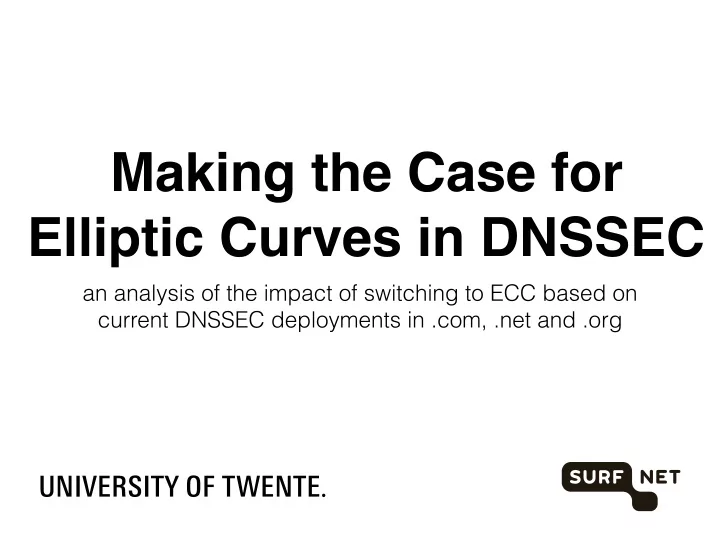

Making the Case for Elliptic Curves in DNSSEC an analysis of the impact of switching to ECC based on current DNSSEC deployments in .com, .net and .org
Introduction • DNSSEC deployment has taken off, but there are still operational issues • Fragmentation • Amplification • Complex key management • Root cause of many of these problems: use of RSA • ECDSA standardised in RFC 6605 (2012), but still sees very little use (but is discussed a lot!)
Fragmentation • Well known problem; up to 10% of resolvers may not be able to receive fragmented responses* • Solutions available: • Configure minimal responses • Better fallback behaviour in resolver software • Stricter phrasing of RFC 6891 (EDNS0) *Van den Broek, J., Van Rijswijk-Deij, R., Pras, A., Sperotto, A., “DNSSEC Meets Real World: Dealing with Unreachability Caused by Fragmentation”, IEEE Communications Magazine, volume 52, issue 4 (2014).
Fragmentation • Setting minimal responses pays off: • But fragmentation still occurs!
Amplification • DNSSEC is a potent amplifier* without DNSSEC combined 30% .com .net 25% .org percentage of domains with DNSSEC .uk .se 20% .nl 15% theoretical maximum amplification of regular DNS 10% 5% 0% 0 10 20 30 40 50 60 70 80 Amplification factor [bin=0.1] * Van Rijswijk-Deij, R., Sperotto, A., & Pras, A. (2014). DNSSEC and its potential for DDoS attacks. In Proceedings of ACM IMC 2014. Vancouver, BC, Canada: ACM Press
Amplification • While ANY could be suppressed, DNSKEY cannot! com 14% net org 12% theor. maximum uk amplification percentage of domains of regular DNS se 10% nl 8% 6% 4% 2% 0% 0 10 20 30 40 50 Amplification factor [bin=0.1]
Root cause: RSA • RSA keys are large • 1024-bit —> 128 byte signatures, ±132 bytes DNSKEY records • 2048-bit —> 256 byte signatures, ±260 bytes DNSKEY records • Also: striking a balance between signature size and key strength means RSA prevents a switch to simpler key management mechanisms* *don’t have time to explain in detail, see paper
ECC to the rescue • ECC has much smaller keys and signatures with equivalent or better key strength • ECC with 256-bit group ≈ RSA 3072-bit • ECDSA P-256 and P-384 are standardised for use in DNSSEC in RFC 6605 (2012) • Used very little in practice, 99.99% of .com, .net and .org use RSA • But there is a lot of buzz around it (CloudFlare!) • EdDSA based schemes have draft RFCs (Ond ř ej Sur ý )
Measuring ECC impact • We performed a measurement study to quantify the impact of switching to ECC on fragmentation and amplification • Study looks at all signed .com, .net and .org domains • Studies ECC scenarios: ecdsa384csk ecdsa256csk eddsasplit ecdsa384 ecdsa256 eddsacsk implementation choice ECDSA vs. EdDSA ECDSA ECDSA ECDSA ECDSA EdDSA EdDSA Curve P-384 P-256 P-384 P-256 Ed25519 Ed25519 KSK/ZSK vs. CSK KSK/ZSK KSK/ZSK CSK CSK KSK/ZSK CSK most conservative most beneficial ← − − − − − − − −− − − − − − − − → fi fi fi fi
Impact on fragmentation • DNSKEY response sizes dramatically reduced: 100% original ecdsa384 98% percentage of domains ecdsa256 ecdsa256csk 96% eddsacsk 94% IPv6 minimum MTU Ethernet MTU (1280 bytes) (1500 bytes) 92% classic DNS 90% 256 512 1024 2048 4096 response size [bytes, log scale]
Impact on amplification • ANY amplification dampened significantly: 10% current situation ecdsa256 8% percentage of domains ecdsa256csk eddsacsk 6% theoretical maximum ampli fi cation of regular DNS 4% 2% 0% 0 10 20 30 40 50 60 70 80 ampli fi cation factor [bin=0.1]
Impact on amplification • DNSKEY amplification practically solved: 45% original theoretical 40% maximum ampli fi cation ecdsa384 of regular DNS 35% percentage of domains ecdsa256 30% ecdsa256csk eddsacsk 25% 20% 15% 10% 5% 0% 0 5 10 15 20 25 30 35 ampli fi cation factor [bin=0.1]
Back to 512-byte DNS? • A and AAAA responses fit in classic DNS! 100% 80% percentage of domains 60% 40% 20% A queries AAAA queries 0% 128 192 256 320 384 448 512 response size [ecdsa256 with minimal responses]
Conclusions • Switching to ECC is highly beneficial and tackles major issues in DNSSEC • Combined with simpler key management it could even bring “classic” 512-byte DNS back into scope • Impact on resolvers is uncertain! ECC validation speeds are up to an order of magnitude slower than RSA • Improvements are being made (e.g. OpenSSL) • We are working on quantifying the impact of this
Recommend
More recommend